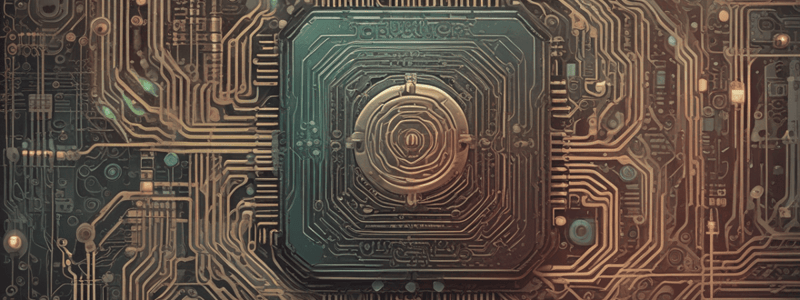Podcast
Questions and Answers
What is a similar device to the Silicon-Controlled Switch (SCS)?
What is a similar device to the Silicon-Controlled Switch (SCS)?
- Thyristor
- Diac
- SCR (correct)
- Triac
Which of the following is a characteristic of the SCS?
Which of the following is a characteristic of the SCS?
- Four-terminal thyristor (correct)
- Unidirectional thyristor
- Two gate terminals
- Three gate terminals
How many anodes does a Diac have?
How many anodes does a Diac have?
- One
- Two (correct)
- Four
- Three
What is the main difference between a Triac and a Diac?
What is the main difference between a Triac and a Diac?
What is a characteristic of a TRIAC?
What is a characteristic of a TRIAC?
What happens to a UJT when the current drops to a sufficient low level?
What happens to a UJT when the current drops to a sufficient low level?
What is the intrinsic standoff ratio of a UJT?
What is the intrinsic standoff ratio of a UJT?
What is the peak-point voltage of a UJT equal to?
What is the peak-point voltage of a UJT equal to?
What characteristic does a UJT exhibit up to a certain value of IE?
What characteristic does a UJT exhibit up to a certain value of IE?
What is the main difference between a UJT and a PUT?
What is the main difference between a UJT and a PUT?
What happens to a UJT after the burst of current from E to B1?
What happens to a UJT after the burst of current from E to B1?
Flashcards are hidden until you start studying
Study Notes
Silicon-Controlled Switch (SCS)
- Similar to SCR, but with two gate terminals (cathode and anode gate)
- Four-terminal thyristor used to trigger the device ON and OFF
- Faster turn-off time than SCR
- Used in counters, registers, and timing circuits
Turning On SCS
- Apply a positive pulse on the cathode gate or a negative pulse on the anode gate
Turning Off SCS
- Apply a positive pulse on the anode gate or a negative pulse on the cathode gate
- Reduce the anode current below the holding current by using BJT as a switch to interrupt anode current
DIAC (Diode for Alternating Current)
- Two-terminal four-layer thyristor that conducts in either direction when properly activated
- Requires breakover voltage to initiate conduction with either polarity across the 2 terminals
- Neither terminal is referred to as cathode
- Contains 2 anodes (anode 1 and anode 2)
DIAC Equivalent Circuit and Basic Operation
- From A1 to A2: Q1 & Q2 forward-biased, Q3 & Q4 reversed-biased
- From A2 to A1: Q3 & Q4 forward-biased, Q1 & Q2 reversed-biased
DIAC Applications
- Trigger circuit for the Triac
- Proximity Sensor circuit
TRIAC (Triode for Alternating Current)
- A bi-directional thyristor used to control the power in AC circuits
- A Diac with a gate control or two SCRs in parallel and in opposite directions with a common gate terminal
- Has two leads designated MT1 and MT2 or A1 and A2
- Has a gate lead which is used to control its conduction, which can be turned on by a pulse of gate current and does not require the breakover voltage to initiate conduction
TRIAC Characteristic Curve
- Current in direction depending on the polarity across the terminal
- Turns OFF when the current drops to a sufficient low level
- Breakover potential decreases as the gate current increases
UJT (Unijunction Transistor)
- A three-terminal semiconductor device with only one pn junction
- A breakover type switching device useful in timers, oscillators, waveform generators, and gate control circuits for SCRs and TRIACs
- Two base leads (B1 and B2) and an emitter (E) lead
- Interbase resistance (RBB) of a UJT is the resistance of its n-type silicon bar
UJT Characteristics
- The ratio of RB1RB1+RB2\frac{R_{B1}}{R_{B1} + R_{B2}}RB1+RB2RB1 is called the intrinsic standoff ratio, designated as η (eta)
- Used with SCRs and Triacs to control their conduction angle
- Vpn is the barrier potential of the pn junction
- Vp = ηVBB + Vpn, where Vp is the peak-point voltage
- At peak-point, VE = Vp and IE = Ip
- Then, VE decreases as IE continues to increase, producing the negative resistance characteristic
- At valley point, VE = Vv and IE = Iv
- Beyond the valley point, the device is in saturation, and VE increases very little with an increasing IE
Programmable UJT (PUT or PUJT)
- A four-layer pnpn device with a gate connected directly to the sandwiched n-type layer
- Unlike in UJT, RBB, η, and Vp can be controlled through R1 and R2 (external to the device)
Studying That Suits You
Use AI to generate personalized quizzes and flashcards to suit your learning preferences.





